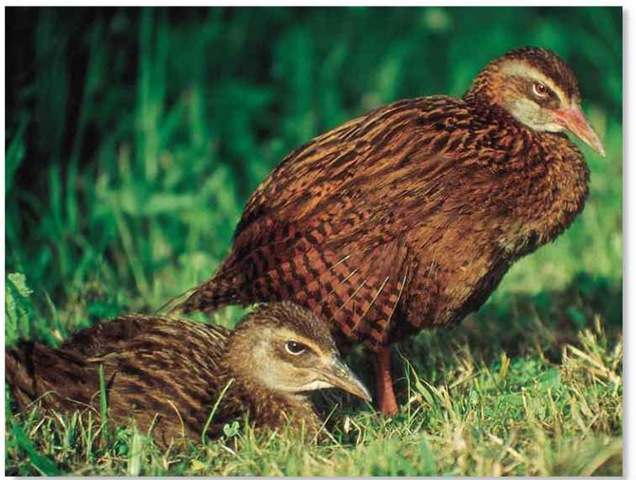ORDER
Gruiformes
FAMILY
Rallidae
GENUS & SPECIES
KEY FEATURES
The flightless weka runs and swims to escape
predators, including cats and dogs
Forms a monogamous pair and often
establishes a permanent territory
Emits a repeated shrill whistle that can be
heard at dawn and dusk
WHERE IN THE WORLD?
Found only in New Zealand; on the larger North, South and Stewart Islands; also D’Urville, Kapiti Island, and the Marlborough Sounds
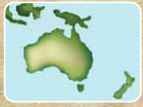
LIFECYCLE
Always on the prowl, the weka seizes any opportunity to snatch a tasty morsel, then scurries away; its feeding area can range from mountains to seashores.
HABITAT

Nest robber A weka grabs a young, naked hatchling and carries it away.
The flightless weka occurs from sea level up to 5,000′, inhabiting forest boundaries, woodland, scrub and grassland, including subalpine tussock grassland. It is found on beaches, particularly those with rotting seaweed, as well as tidal creeks and bays, at the margins of estuaries and on freshwater wetlands. Not disturbed by human neighbors, the weka frequents modified habitats such as lawns, pastures and plantations. It prefers drier areas of low vegetation and avoids forests with no suitably dense understory. In higher elevations, weka have been spotted in hills, mountains and rocky seashore cliffs.
Many flightless weka are accidentally killed while walking across New Zealand roads where weka populations are high.
Showing remarkable homing ability, one bird returned to its home territory after relocation from 80 miles away.
FOOD & FEEDING
An opportunistic feeder, the weka forages mainly for native fruits, invertebrates and small vertebrates, including marine life, lizards, frogs, mollusks, rats and mice. The bird feeds both night and day covering up to 1 mile on the ground while using its bill to uncover anything from bird eggs to fungus. The weka also searches debris piles on the beaches for seaweed and scavenges at camp sites, flicking through the litter with its sturdy bill.This omnivorous hunter will eat chickens, young rabbits and bird eggs, using its bill to spear and carry the prize away. For larger victims, the weka hammers away with its bill while holding down the object with its feet. The bird also follows pigs to search the animal’s rooting sites and scavenges carcasses along the way.
SCAVENGER AT WORK

Beach patrol…
The weka carefully surveys the beach for rotting seaweed, an epicurian delight.
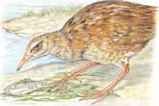
Exposed…
Perseverance pays off when the weka uncovers a dead fish underneath the seaweed.
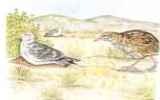
Egg hunt…
The presence of this kelp gull indicates a nest — and probably up to three tasty eggs.
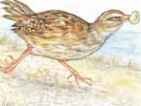
A thief on the run
Wasting no time, the weka spears the egg and flees, leaving the adult gull no choice but to watch.
BEHAVIOR
Weka are more often heard than seen, calling year-round and often setting off a chain reaction among other weka that join in. The main call is a shrill, far-carrying cry normally heard in the early evening, often given by a pair in a practice called duetting. This call is often described as a high-pitched wee-eek, wee-ee-eek, hence the bird’s common name, and is used to announce each weka’s territory. Aggressive encounters evoke a deep, resonant booming, doon<foon<foon.Weka are usually shy and retiring, though some, especially those on the islands, are quite bold, even taking food from human hands. Adult weka remain in their territories while juveniles will disperse up to 5.5 miles from their place of birth.The flightless bird is quite an accomplished swimmer, often crossing more than 0.5 mile of river; lake or sea.
► Sudden stretch Flightless, the weka uses its legs more than its wings.
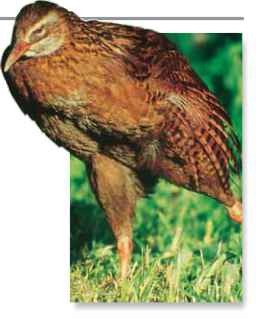
CONSERVATION
Weka populations range from rare to common depending on the region and food availability. Maori and early European settlers used weka for food, oil and feathers. By the 1900s, weka populations declined dramatically and became extinct in most of North Island and eastern South Island. Several factors may have contributed to this decline, including conversion of forests to farmland, the use of poison baits and predators, such as cats and dogs. The North Island weka is listed as threatened because of its declining distribution. The Royal Forest and Bird Protection Society and Otorohanga Kiwi House have begun a successful captive-breeding program.
BREEDING
The sedentary weka often maintains a permanent territory. Pair bonds are usually for life. Because of the secretive nature of the weka, not much is known about certain courtship behavior, but it is assumed that courtship includes feeding and mutual preening, common in rails.The nest is constructed on dry ground located under tussocks, logs, stumps or rocks, in tree hollows and even outbuildings.The bowl-shaped nest, built by both sexes or the male only is made of grasses, twigs, moss, feathers, wool, hair and leaves. The male incubates the 2-6 creamy-white or pinkish eggs at night, and the female does so during the day After about 27 days, hatching occurs over several days; the first and strongest chicks receive the most food.The chicks are able to leave the nest after only three days, but the parents care for them for 40-108 days. Weka may breed cooperatively, with chicks being fed by another adult or by juveniles of a previous brood.
Baby steps
Weka chicks are able to walk days after hatching.
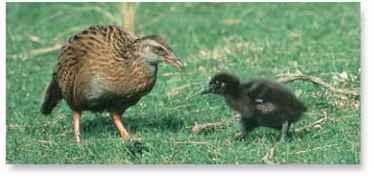
PROFILE
Weka
The flightless weka runs swiftly to avoid predators and walks up to 1 mile in search of food, using its bill to uncover hidden treats.
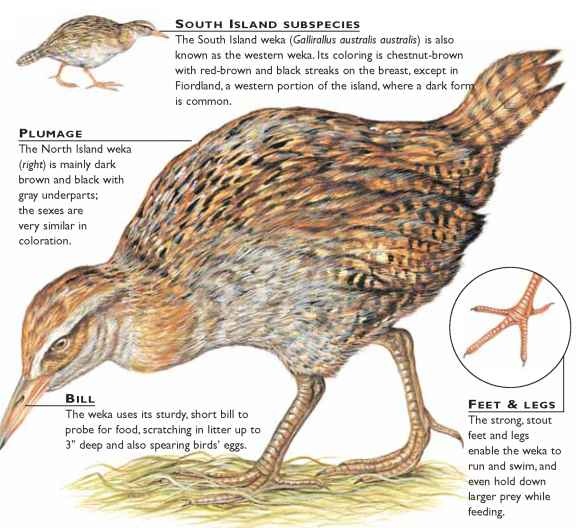
CREATURE COMPARISONS
The New Guinea flightless rail (Megacrex inepta) lives in mangrove forests, wet thickets, swamp forests and riverine bamboo thickets in the lowlands of New Guinea. More often heard than seen, the rail’s voice is shrill and reminiscent of the squeal of a baby pig.This smaller relative of the weka reaches up to 15″ in length. Its heavy legs are longer than the weka’s, but its tail is shorter: Like the weka, it runs swiftly to avoid predators, and also flicks its wings upward while moving around.
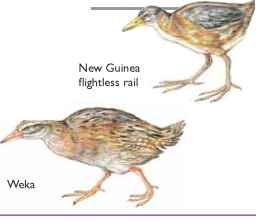
| VITAL | |
| STATISTICS | |
| Weight | Male up to 2.2 lbs.; female up to 1.5 lbs. |
| Length | 21″ |
| Wingspan | Up to 24″ |
| Sexual | 5-12 months |
| maturity | |
| Breeding Season | August-March |
| Number of Eggs | 2-6 |
| Incubation Period | 26-28 days |
| Nesting Period | 2-3 days |
| Breeding | Up to 4 broods |
| Interval | a year |
| Typical | Fruit, seeds, roots, fungi, insects, eggs, vertebrates |
| Lifespan | Up to 15 years |
RELATED SPECIES
• The weka is one of 10 ( species in the genus I Gallirallus, which includes the flightless New Caledonian rail, G. lafresnayanus, and the Guam rail, G. owstoni, which can fly only 10′ at a time. A total of 133 species of rail, gallinule and coot belong to the weka’s family, Rallidae. The family’s smallest member is the 5″-long black rail, Laterallus jamaicensis; the largest is the takahe, f Porphyrio mantelli.
